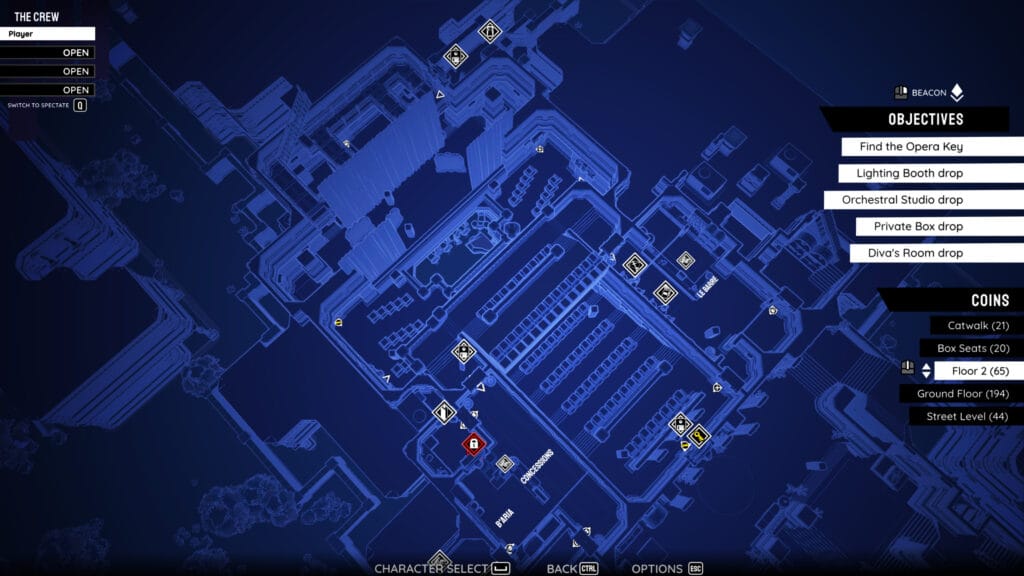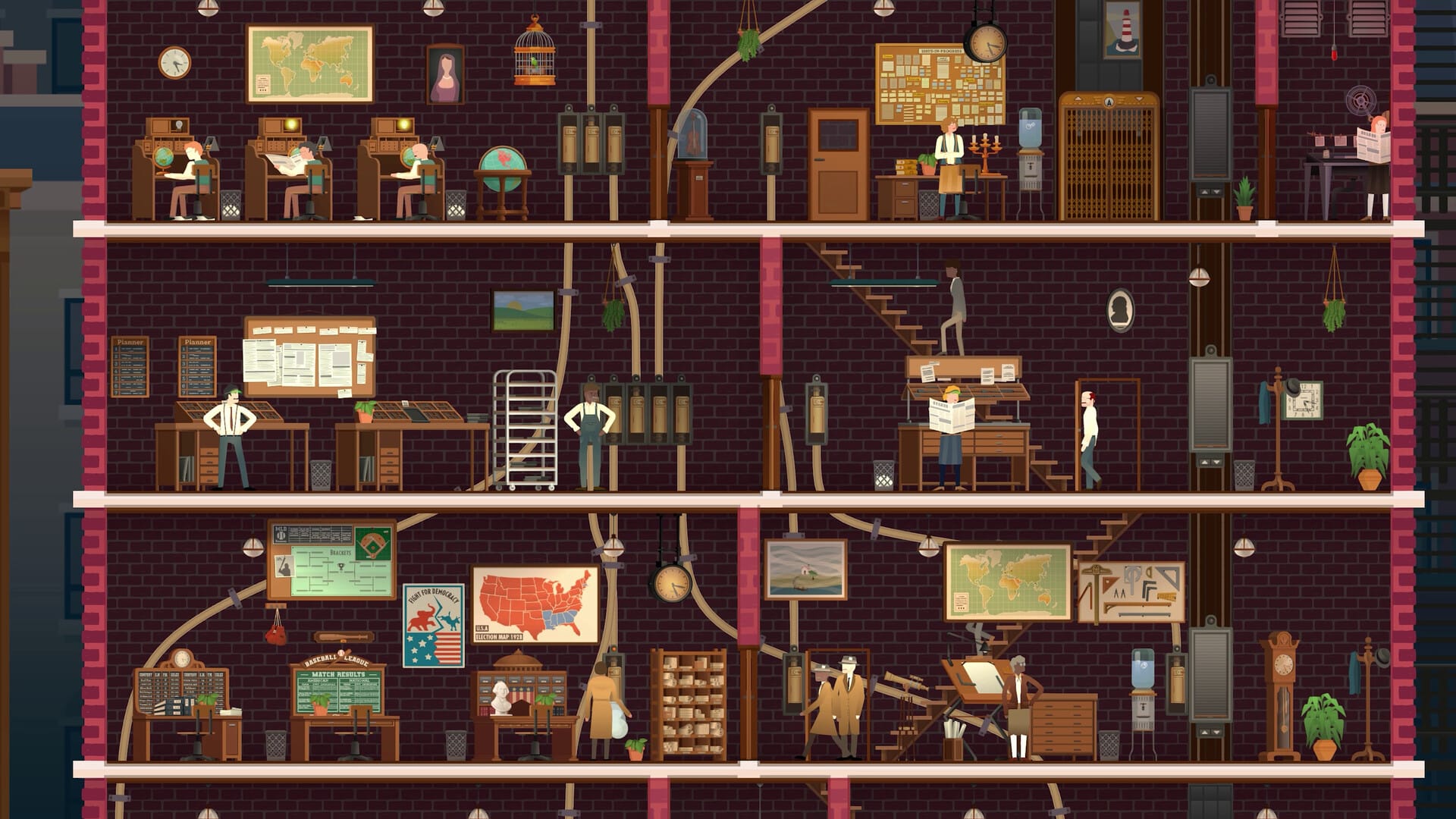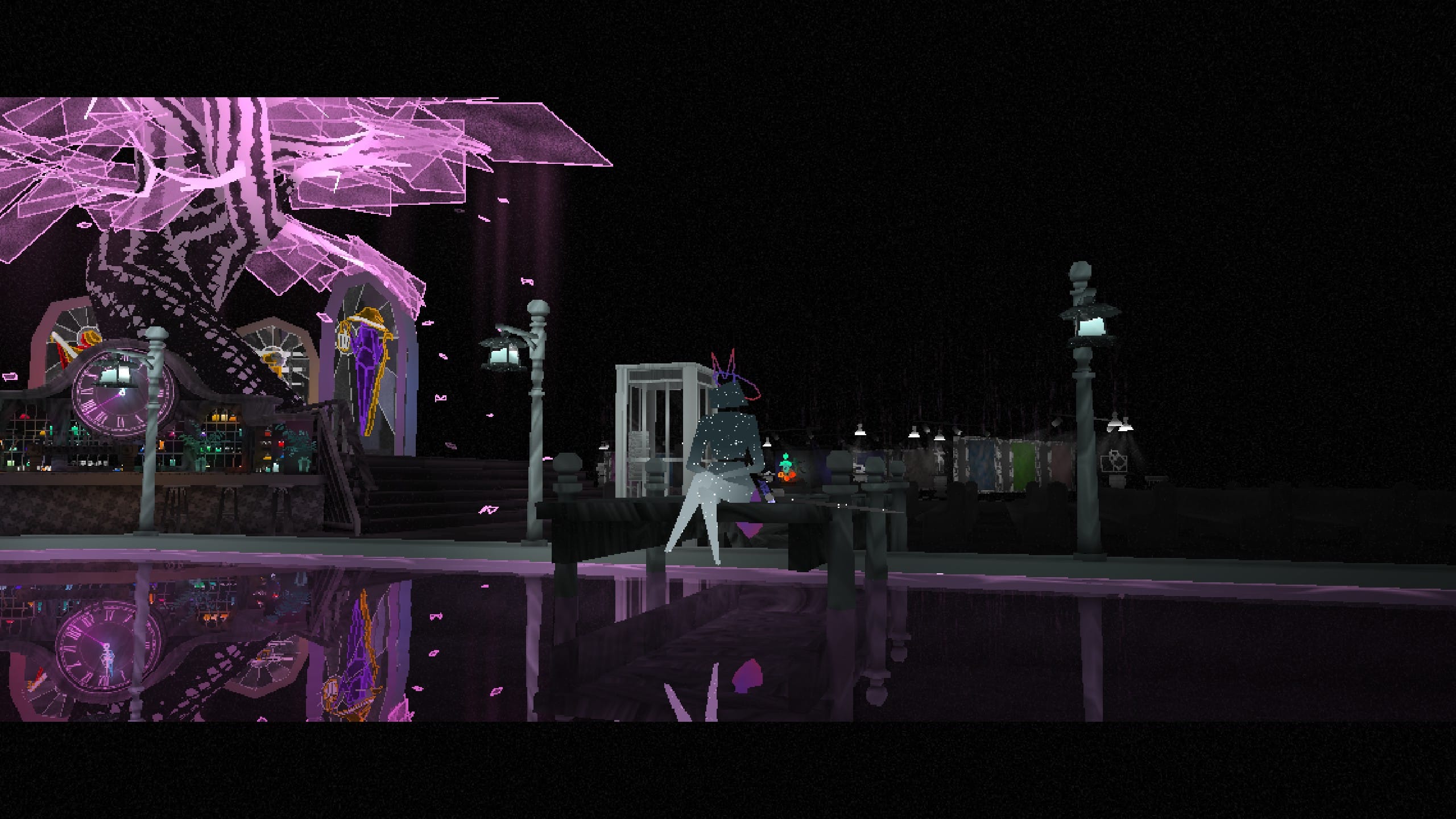There’s a particularly funny moment I think about frequently regarding Monaco 2.
Myself and another player were roaming about an opera house to plant evidence regarding the identity of a “mystery donor” to the local security group and reached a point where one of our objectives was placed behind heavy guard. The door was locked and had two bulky shotgun-wielding officers outside. The floor below it was similarly well-guarded: a few guards patrolling and a couple of lasers that slowly moved back and forth across the room. We’d been stuck trying to figure out how to get through for a while.
Our first approach had been to try hacking the lasers and knock out the guards using crossbows so we could get upstairs to our objective. The problem: the closest terminal to hack was in the room along the path of the lasers, and the lever to turn them off was tucked away in a corner we couldn’t reach without tripping the laser. We tried to slowly clear out guards anyway to give ourselves more room to maneuver, but the lasers kept that from working due to us getting caught by them while carrying bodies and thereby relocking the doors we needed to get through. We’d have to drop them to pick the locks, which would give them time to wake up before we could resume carrying them. We’d already lost a couple of lives at this point and had a previous run on this level end here before. There had to be a way through.
Then I had a breakthrough: there’s a pickaxe nearby. We could use that to burrow under the door and get the objective. All we needed to do was get upstairs and find an opening in the guard patrols to get in position and start digging. We’d been thinking up all these elaborate plans on how to get in that we missed the obvious solution. It was so simple!

Monaco is a cooperative heist game for up to four players wherein you attempt to clear a level of all its loot and make a clean getaway. The story of Monaco 2 follows a group of thieves who get blackmailed into helping a local kingpin take control of the city through an ever escalating series of jobs. There are eight playable characters each with their own abilities. Cosmo can use her dog Gimlet to distract guards, for example, while Jobbie can teleport himself and allies around to bypass security measures. Pockets acts as the medic, able to heal himself and allies at will, while Cicero can sneak up behind guards and put them to sleep for a limited time.
Everyone can also alter their abilities using trinkets you can buy in exchange for diamonds you earn for completing extra objectives. Collecting all the coins in a level, hitting a certain score threshold, and finishing the level in a certain time all award you with diamonds to spend. You can also play through a remixed version of each level, where the game randomly alters its layout via procedural generation, to double your earnings. The trinkets range from mere upgrades to completely altering how their unique abilities work. Cosmo for example can either use one that enables direct control of her dog to collect coins but lose the ability to distract guards while doing so, or take one that allows the dog to distract four targets at once. Likewise, Jobbie can increase his teleport speed or be able to instantly disguise himself while standing still. You can also swap trinkets mid-mission at checkpoints, allowing you to change your approach to suit your current needs.
The biggest difference from the previous game is that each level limits who you can play as. Before, as your cadre of thieves grew, you could choose to play as any of them once they joined the crew. In Monaco 2, you can only play as whoever’s been chosen for that caper. It’s ultimately a good change. In the last game, I inevitably ended up playing only a select few characters for most of the game because I didn’t feel particularly pushed to branch out when playing solo. Here, because you have a set crew per mission, there’s a greater incentive to learn how to play everyone and figure out where their strengths are best applied.

Monaco 2 feels most like a puzzle when played solo. Figuring out how to bypass rooms filled with guards and lasers requires a mix of creativity and a willingness to throw all caution to the wind. For every level I could clear with stealth and patience, deftly avoiding the gaze of security robots on patrol and hacking lasers and doors to open otherwise inaccessible paths, where Monaco splendidly captures the tension of classic stealth games, there were just as many where I couldn’t play it safe and had to take risks or set up elaborate plans to create a mere chance of success.
In one of the early missions, where you’re breaking one of the crew out of prison, there was one sequence just before the end of the level where I had to figure out how to bypass a small room filled with lasers, equipped with turrets that would activate upon an alarm, and avoid the guards walking around. In most cases, the obvious answer would be to hack a terminal and create some bugs to disrupt the security measures as you move through the room. But there weren’t any terminals nearby, nor any EMPs I could use instead. Smoke grenades would work well, but I didn’t have any on me at the time. A crossbow would knock out the guards temporarily, which would help give me time to hack each device by hand, but I hadn’t seen one in a while. There are plenty of solutions I could use, but I didn’t have any of those tools within reach. I didn’t have many options available except to force my way through.
First I tried using Gibson, the engineer of the group who has a drone he can deploy to hack devices, unlock doors, or pick up items from afar, to hack some lasers as I moved forward. Worked fine until a guard caught sight of me, at which point I had little choice but to hope I could unlock the door before they started attacking. When the alarm rang, more guards started filling the room, meaning I needed to deal with them if I wanted to get through. So I swapped to Uma, the muscle of the group, to stun them and, I hoped, give myself enough leeway to unlock the door and escape. That didn’t get me far. So I finally swapped to Sake and just bolted: rolling through lasers to evade detection and to stay ahead of the guards in pursuit until I could find a place to hold up. It was a gamble. It took a few tries to work by that point, and I cut it close when I finally did get past that room, but it did eventually succeed.

At its best, Monaco 2 puts you in desperate situations and forces you to improvise. It’s not a stealth game where you can reasonably get through a level without ever being seen or setting off alarms. It purposefully creates spaces where pure stealth is often the harder route as, unless you’ve planned every move out perfectly, there’s always a good chance you’ll get caught by someone or something while trying to unlock a door or that safe you decided to make a detour for. In solo play, especially, it’s a very difficult game, just like its predecessor. Oftentimes I would fall back on slowly picking off guards one at a time with a crossbow then hiding the bodies to remove them from the field permanently. It’s a very slow and, admittedly, boring option, but a reliable one when I’m down to my last life with the end of the mission in sight.
In multiplayer, however, Monaco 2 thrives. The chaos that erupts from four players running around as alarms blare in multiple locations, guards scrambling to investigate as everyone looks for a closet or plant to hide in or at least a busy enough room to shake their pursuers in, is great comedy. And the ease that cooperation brings to many of Monaco’s toughest scenarios by using each character’s skills in tandem demonstrates how well the crew’s abilities aid one another. It embodies the thrill of a good heist where everything can fall apart at a moment’s notice, whether through poor foresight or a simple unpredictable variable, forcing you to think on your feet and adapt. Hatching potential plans and testing how viable they are is where most of the fun comes from, particularly in the ways everything inevitably goes awry.
I rarely had the chance to play the previous game in multiplayer due to lacking the means of setting up local play. That’s changed in the years since and being able to play Monaco 2 with a full crew was a definite highlight. Cooperative games are often an almost guaranteed good time, and Monaco‘s specific mix of careful stealth and planning and utter chaos still hits all these years later. The little ways Monaco 2 differs from its predecessor give it its own unique feel while still maintaining the core of what makes these two games spectacular.
Callum Rakestraw (he/him) is the Reviews Editor at Entertainium. You can find him on Bluesky, Mastodon, and his blog.





